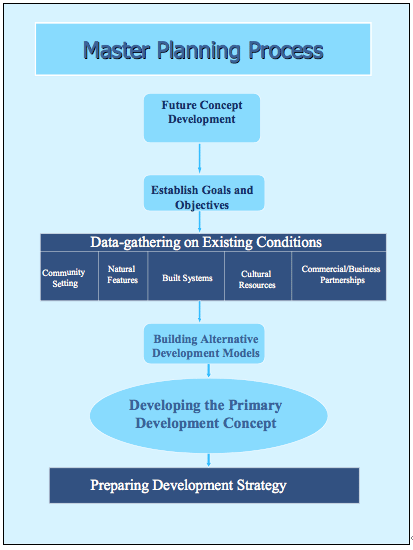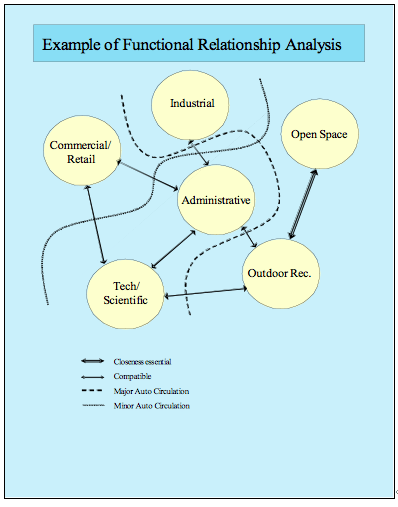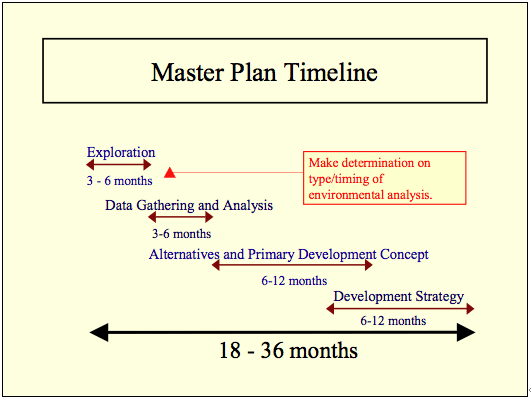Chapter 2. The Master Planning Process
2.1 Phased Development
2.1.1 Each Center shall develop the CMP through the following phased process. The phased approach allows the CMP to be based on consideration of the current capabilities of the Center to support its mission as well as developing alternatives to ensure the Center is able to support future requirements.
2.1.1.1 Exploration - Exploration is a process that aids in the Center determining its direction and needs. The Center is to consider future potential endeavors by NASA and determine if they are within the Center's capabilities. The Center needs to establish its goals to support its view of the future including goals of stakeholders (internal and external) that might be different from the Center's goals.
2.1.1.2 Validation - Validation involves establishing, at the start of the planning process, a current assessment of the Center, its mission, the Center's assets, and the assets of the surrounding community that are used to achieve the mission, and the values important to the Center.
2.1.1.3 Hypothesis and Testing - This phase involves the development and test of various alternatives for development of the Center. What alternatives are to be considered to achieve the future concept for the Center? It may be necessary to forecast future demand for the Center's products and services, or perform market analyses to establish possible alternatives to be considered. Use models to compare the costs and benefits of the various alternatives being considered. (For example, life cycle cost analysis.)
2.1.1.4 Primary Development Concept - Establish consensus on the future development of the Center to be depicted in the CMP.
2.1.1.5 Development Strategy - Prepare plans for achieving the primary development concept, identify the timeline or phases necessary to achieve the primary development concept. The proposed plans are to reflect the best current thinking about facilities engineering, life-cycle cost, sustainability, and aesthetics.
2.1.1.6 Safety and Mission Assurance Planning - All strategic planning shall include a risk identification and initial risk assessment as an overt part of the planning process. Mitigation and elimination of the identified risks shall be included in the planning process.
2.2 Exploration - Establishing the Center's Future Concept
2.2.1 The master planning process begins with the Exploration phase to establish the concept of the Center's future. The future concept for the Center needs to be well documented and have senior management endorsement before it can be translated into a master plan.
2.2.2 The Center's future concept shall contain the Center's goals and objectives and shall articulate the overall strategy for:
- Changes to physical infrastructure.
- Necessary acquisitions to develop or expand capabilities (or even to contract capabilities).
- Partnerships with other organizations including governmental and non-governmental organizations.
- Optimal utilization of intellectual capital inside and outside the Center.
- Environmental review and analysis for overall plan and resultant projects.
- Changes in the management structure.
- Changes in the Center's context with the host community.

Figure 2-1 The Master Planning Process
2.2.3 As the first step in developing the CMP, the Center Director shall establish a CMP Steering Group composed of individuals from the senior leadership of the various components at the Center to establish the future concept of the Center through the Exploration phase. The CMP Steering Group is to develop a broad concept of the Center's future, and the steps necessary to achieve it. The Steering Group will:
- Establish the Center's future concept.
- Oversee development and testing of alternatives.
- Oversee selection of the primary development concept.
- Oversee development of the CMP.
2.2.3.1 The Steering Group must include representatives from the major programs supported at the Center, as well as a representative from the Center Facilities Office and the Center Planning Office. The Steering Group will develop a Center Master Planning team composed of planners, stakeholders, and technical experts to develop the data and construct the models for the CMP.
2.2.4 The future concept for the Center must be consistent with NASA's Strategic Plan, NASA's Strategic Real Property Plan, Mission Directorate Plans, and the Center's Implementation Plan (see Figure 2-1). The future concept of the Center shall be based on an integrative approach that considers the synergy between natural features and built systems. This integrated approach shall be used in defining the primary concept for future develpment and alternative development models.
2.2.5 The type of environmental analysis required and the timing of that analysis is to be determined early in the CMP process and in consultation with the Center Environmental Management Office and in accordance with existing NASA policy. Each Center is required by NASA regulations to maintain an Environmental Resources Document (ERD). The ERD can be a valuable tool in the CMP process since it identifies areas of environmental and cultural resource sensitivity.
2.2.5.1 The NEPA and environmental review process is not limited to the primary development concept alone. Sufficient information must be gathered on reasonable alternatives to permit a meaningful comparison among the alternative concepts thereby providing a clear basis for choice among options by the NASA decision maker and the public. The process described in this guide for developing and testing alternatives will provide information for this comparison.
2.2.6 Following the Exploration phase and preparation of the Center's future concept and the goals and objectives, the Steering Group shall oversee the collection and analysis of data during the Validation phase.
2.3 Validation - Data Collection and Analysis
2.3.1 A considerable amount of data must be collected and analyzed to support the efforts of the Steering Group during the Validation phase. The analysis of the data will aid in the development of the alternatives, as well as in the preparation of the CMP. Much of this data resides in existing databases or may be contained in the current master plan.
2.3.2 An analysis of the collected data is necessary to determine the significance of current and projected conditions on the future concept for the Center. Proper analysis will define how current and projected conditions will affect future development and how improvements can be made to meet future needs.
2.3.3 The data shall be collected in two broad categories:
- a. Data concerning "Community Setting and Natural Features".
- b. Data concerning "Existing Conditions and Built Systems" on the Center.
2.3.3.1 Community Setting and Natural Features. The Center's geographical location and physical relationship to adjoining jurisdictions are examined in terms of regional conditions and trends. This examination shall include the following:
- The characteristics of the region.
- Land use conditions - both existing and planned land uses immediately outside and adjacent to the Center.
- Major transportation facilities in the region.
- Socioeconomic conditions.
- Current and planned community services.
- Availability of local utility services.
- Local metrological and geological condition.
- Sole source drinking water supplies.
2.3.3.2 Existing Conditions and Built Systems. Existing natural and man-made conditions on the Center.
- The natural environment - existing open spaces on the Center.
- The human environment - current and forecasted population trends for the Center (both civil service and contractor community), historic and cultural resources present on the Center, as well as campus amenities such as food services, day care, recreational, health and safety services available on the Center.
- Existing land uses - land use patterns on the Center and the local area.
- Center transportation network.
- Center utility systems including historical and projected Center consumption rates and peak demands.
- Buildings and other facilities including information on sufficiency to support the Center's mission including the age and existing condition of the buildings.
- Environmental liabilities, hazardous sites, and conditions.
- Existing legal and regulatory conditions affect land use including permits and agreements with others.
2.4 Summary of Existing Constraints and Opportunities
2.5 Hypothesis and Testing
2.5.1 With the data and analysis from the Validation phase, the Center is prepared, during the Hypothesis and Testing phase, to create the alternative development models that can achieve the Center's future concept developed during the Exploration phase.
2.5.1.1 The CMP Steering Group shall:
- Identify alternative development models. The Center's stakeholder community shall be involved in this task and technical experts can be used to help determine the optimum scenarios for future development.
- Evaluate the alternatives and identify the best of the alternative development concepts. The eventual primary development concept may possibly be a combination of two or more of the alternative development concepts under consideration.
- Specify planning horizons that are the intermediate phases for implementing the long-range primary development concept.
- Identify detailed targets (in terms of quantities, qualities and time periods) to measure whether the established goals and objectives are being achieved.
2.5.1.2 The following factors shall be considered in the development of the alternative development models:
- Optimizing Center resources.
- The need to adjust operational capabilities to carry out the current and future missions of the Center.
- Resolution of functional constraints in the current Center infrastructure.
- Community concerns, including cultural resources, as well as environmental concerns and constraints.
- Unifying organizations and functionally similar activities.
- Minimizing the negative impacts of change.
- Providing a stable program support environment in line with the Center's competencies.
- Implementing a proper management structure that supports its model.
2.5.1.3 Identify the functional relationship of activities at the Center. The identification of existing functional relationships at the Center requires an analysis of the broad range of organizations and activities at the Center and the natural flow that takes place between these activities or organizations. Functional relationships exist where there are dependencies between organizations and activities at the Center. A functional dependency exists where the efficient performance of an activity within one area of the Center depends on maintaining or enhancing the flow of activity that originate, continue, or conclude in another area. Conversely, there may be activities that are incompatible and need to be physically separated from each other.
2.5.1.4 Functional relationships can be graphically depicted to enable the preparers of the concept models to better understand the dynamics of the Center's activities (See figure 2-2). For some Centers, the complexity of activities may need to be shown in several separate graphical depictions.
2.5.1.5 Specific consideration shall be given to the following broad functional relationships:
- Administration - Consideration shall be given to the possible benefit of centrally locating the administrative facilities and functions on the Center in order to be easily accessible to all Center activities.
- Industrial/Operational - Consideration shall be given to the possible benefit of grouping these types of facilities in one or two nodes with buffer zones separating them from recreational, administrative and commercial areas.
- Commercial/Retail - Consideration shall be given to the potential benefit of grouping these types of facilities in one or two nodes that are easily accessible to the various Center activities.

Figure 2-2 Example of Functional Relationship Analysis
- Technical/Scientific - Consideration shall be given to the potential benefit of grouping these types of facilities/functions to promote accessibility and collegiality.
- Supply/Storage - Consideration shall be given to the potential benefit placing the supply/storage function near the perimeter of the Center, if possible to allow deliveries of supplies without the need to pass through congested areas of the Center.
- Security - Consideration is to be given to whether all areas or functions on the Center require the same level of security. This may lead to changes to the security perimeter of the Center.
- Recreation - Consideration shall be given to the potential benefit of grouping passive and active recreation areas located outside of industrial areas on the Center.
2.5.2 Alternative development models describe specific functional relationships as well as the spatial arrangement of the Center's real property assets that can support a specific view of the Center's future development. Alternative development models are to depict logical arrangements for the Center's real property assets that best represent the ideal spatial relationship of the facilities to support the specific alternative being considered. Different alternatives allow for comparison of the various tradeoffs considered in choosing the primary development concept.
2.5.2.1 The following five elements are to be addressed in the alternative development models.
- Community Setting - This element is to include population, land use and transportation patterns external to the Center.
- Natural Features - This element is to address the Center's topography, geology, hydrology, wetlands, vegetation, and animal communities and open space.
- Built Systems - This element is to include a list of the Center's infrastructure. At minimum, the following sub-elements shall be addressed:
- Buildings and Structures.
- Utilities, Communications Systems and Environmental Systems.
- Transportation Systems and Improvements.
- Campus Amenities and Landscape Design.
- Emergency Response, Safety and Security Management.
- Offsite/Non-Contiguous Facilities (owned and leased)
- Cultural Resources - This element is to include the cultural, historic and archeological assets present on the Center.
- Commercial/Business Partnerships - This element is to address the infrastructure on the Center that is related to the various Public/Private Partnerships existing on the Center. This element also includes tenant activities and contractor activities on the Center.
2.5.3 The alternative development models are to be analyzed and tested to determine which is the most effective in reaching the Center's future concept. This analysis involves comparing an ideal functional arrangement with the existing physical constraints and opportunities at the Center. Alternative development models are to be tested against their ability to achieve the Center's future concept, goals and objectives. The following criteria shall be used in developing and comparing alternative development models:
- Ability to efficiently meet the Center's operational requirements.
- Flexibility to respond to changing future conditions and needs.
- The economic (cost vs. benefit) feasibility of alternatives.
- Security provided for sensitive functions and controlling access to the Center.
- Physical compatibility of uses or functions for buildings and land.
- Separation of hazardous operations from populated areas.
- Energy efficiency and water conservation.
- Preservation of environmentally and culturally sensitive areas.
- Correction of traffic circulation or utilities problems.
2.6 Building the Primary Development Concept
2.6.1 A Primary Development Concept is derived from the alternative development models that are built and tested by the CMP Steering Group. The Center's primary development concept is the best of the alternatives tested. It may be chosen one of the various alternatives tested, or it may consist of the best elements from several of the alternatives available.
2.6.2 Throughout the development of the alternative development models and in the development of the primary development concept, the need for an environmental analysis of any resultant major actions such as reduction or increase of operations or construction of facilities needs to be considered. It is imperative that the Center Environmental Management Office be consulted throughout the process to ensure that the correct level of analysis is performed and the environmental analyses are begun and completed at the appropriate times.
2.6.3 Sustainable design principles must be incorporated into the primary development concept to reduce life-cycle costs. The essential elements of NASA's sustainable design principles are found in NPD 8820.3, Facility Sustainable Design.
2.6.4 Design principles for all facilities and infrastructure shall include elements necessary to meet applicable codes and regulations including the Americans with Disabilities Act. NPR 8820.2E, Facility Project Implementation Guide, and associated directives/regulations address these and other necessary design considerations.
2.7 Preparing a Development Strategy
2.7.1 The Development Strategy consists of the proposed plans for achieving the primary development concept, as well as identifying the timeline or phases necessary to achieve the primary development concept. The proposed plans are to reflect the best current thinking about facilities engineering, life-cycle cost, sustainability, as well as aesthetics.
2.7.1.1 The preparation of the Development Strategy and the specific Centers projects and other major actions will require an environmental analysis at the appropriate time. The Center is to have made a determination of the type and timing of environmental analysis early in the CMP process. That determination and any follow-on decision on environmental analysis must be made through consultation with the Center Environmental Management Office and in accordance with existing NASA policy.
2.7.2 The CMP Development Strategy is to identify the highest priority projects that are required to develop the Center in accordance with the primary development concept. These projects include facility construction and demolition as well as utility and infrastructure changes.
2.7.2.1 Projects are to be grouped in related sets by fiscal year that accomplish the development objectives of the primary development concept. The projects are to be prioritized and sequenced for construction or demolition within succeeding five year periods from adoption of the CMP.
2.7.2.2 Prioritization is to include the extent to which the project carries out a specific objective identified in the CMP. In this regard, analyze the following questions:
- Will the project contribute to the long-term development of the Center in accordance with the primary development concept?
- Will the project contribute to other projects on the Center that are necessary or already underway?
- Does the project resolve a current problem or need, or is it necessary to carry out other needed projects, i.e., does it resolve a critical functional deficiency?
- Can the project be funded within programmed levels or otherwise available amounts?
2.7.2.3 A Mission Dependency Index (MDI) may be utilized to evaluate the criticality of the current and planned facilities at the Center. A MDI is an operational risk management assessment used to rank the criticality of facilities at an installation. Identifying critical facilities will assist in prioritizing new construction needs as well as identifying necessary maintenance and repair investments.
2.7.2.4 The Development Strategy is to identify proposed funding sources to accomplish the identified projects.
2.7.3 The CMP Development Strategy is to be updated annually, to reflect the projects that have been previously implemented and those that remain necessary to achieve the primary development concept.

Figure 2-3 Master Plan Development Timeline]
DISTRIBUTION:
NODIS
This Document is Obsolete and Is No Longer Used.
Check the NODIS Library to access the current version:
http://nodis3.gsfc.nasa.gov
![[NASA Logo]](../Images/nasaball.gif)


